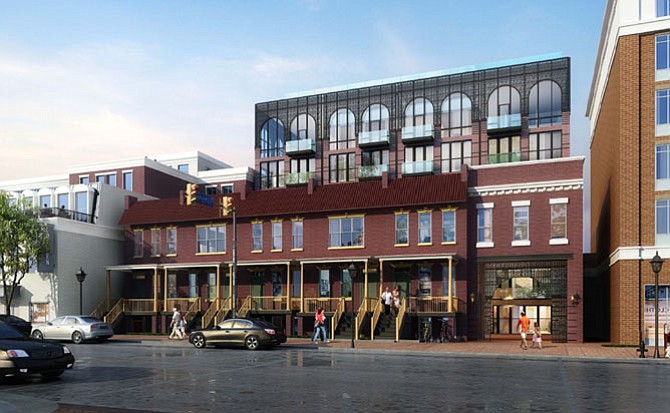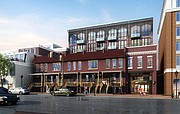The iron design for 1604-1614 King Street by Michael Winstanley Architects and Planning. Photo contributed
No one at the Board of Architectural Review (BAR) meeting on July 5 had any reservations about replacing the aged and dilapidated structure at 1604-1614 King Street that currently houses the Gazette Packet and the Dust Farm skate shop and museum. But the ongoing question is whether the new building should stick to the historic stone facade or take a risk on iron latticework. For local residents and members of the BAR, it’s a decision that will set precedent for the future architecture of upper King Street.
The original proposal for the new building, brought to the BAR in December 2016, showed a glass topped building with irregular spacing set overtop of a refurbished version of the current structure. However, in response to feedback from the BAR and local citizens, the design has evolved into a more traditional pair of brick building designs whose main difference is the inclusion of metal tracery on the upper floors. In a report prepared by city staff, there was support for the idea of metalworks on the facade of the building, but without any prior precedent along King Street the suggestion was to play it safe with a stone topping. Staff cited BAR design guidelines discourage following trends for individual buildings at the cost of historic cohesion: “As a general rule, the Boards favor contextual background buildings which allow historic structures to maintain the primary visual importance. Singular buildings in the latest architectural vocabulary are generally discouraged. It is not the intention of the Boards to dilute design creativity in new commercial buildings. Rather, the Boards seek to promote compatible development that is, at once, both responsive to the needs and tastes of the late 20th century while being compatible with the historic character of the districts.”
The public feedback on the new design was mixed, but most expressed support for the idea of a metal facade reminiscent of earlier industrial buildings.
“This property is a unique transition from historic Old Town to the upper King street and the West End,” said Phillip Mattis, representing the Old Town Citizen’s Association, supporting the metal tracery. “Not everyone liked the Eiffel Tower when it was put up, but people pay a lot of money to go there today.”
“Given a choice, I would like to see a cast metal design of the entire building façade reminiscent of the historic cast iron buildings in Soho and other places,” said Charles Christopher, a local resident, in an email to the BAR.
Opinions on the BAR were more divided, but one subject of unanimous agreement was that something needs to be done to bring new life and style to upper King Street. Margaret Miller, one of the board members, expressed her agreement with characterizations of upper King Street as dull and in need of revitalization. At the work session’s end, the BAR endorsed the scale, mass, height and general architectural character of the building, with Miller and BAR member Slade Elkins dissenting. Elkins was the lone voice of support for the original glass building, saying the new designs didn’t go far enough to excite the architectural character of the neighborhood.
“I would love to see more of what was on the drawing board,” said Elkins. “It seems you heard ‘do traditional’ and you went ‘eh, OK.’ I get it, you responded, but I think it was more dynamic with the glass you started with.”

